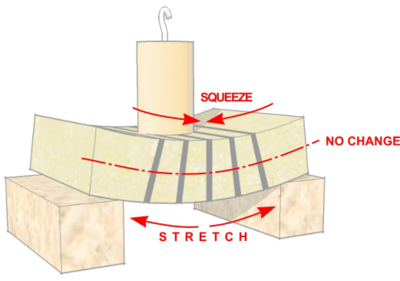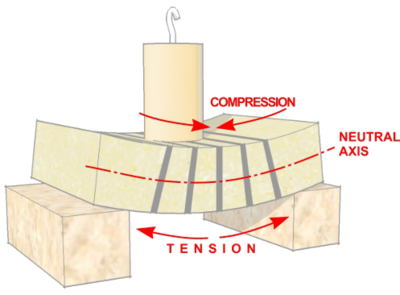Neutral Axis: Difference between revisions
From DT Online
(Created article) |
m (Added images) |
||
| Line 1: | Line 1: | ||
As beams bend, the top experiences forces which squeeze it together (compression), and the bottom of the beam is stretched (tension). But the centre line of the beam is unaffected and is known as the | As beams bend, the top experiences forces which squeeze it together ''(compression)'', and the bottom of the beam is stretched ''(tension)''. But the centre line of the beam is unaffected and is known as the '''Neutral Axis'''. | ||
:::[[File:SpongeNeutralAxis.png|400px|bottom]][[File:SpongeNeutralAxis2.png|400px|bottom]] | |||
Simple beam bridges have to withstand all these forces which due to their own weight and the loads which are applied. If the material used is unsuitable it will break ''(e.g. like a stick of chalk)'', or if there is not enough of it to share the loads within it, then the beam may collapse ''(e.g. as the thin sheet of card will)''. | Simple beam bridges have to withstand all these forces which due to their own weight and the loads which are applied. If the material used is unsuitable it will break ''(e.g. like a stick of chalk)'', or if there is not enough of it to share the loads within it, then the beam may collapse ''(e.g. as the thin sheet of card will)''. | ||
[[Category:Terminology]] | |||
[[Category:Beams]] | |||
Revision as of 20:50, 17 December 2015
As beams bend, the top experiences forces which squeeze it together (compression), and the bottom of the beam is stretched (tension). But the centre line of the beam is unaffected and is known as the Neutral Axis.
Simple beam bridges have to withstand all these forces which due to their own weight and the loads which are applied. If the material used is unsuitable it will break (e.g. like a stick of chalk), or if there is not enough of it to share the loads within it, then the beam may collapse (e.g. as the thin sheet of card will).

